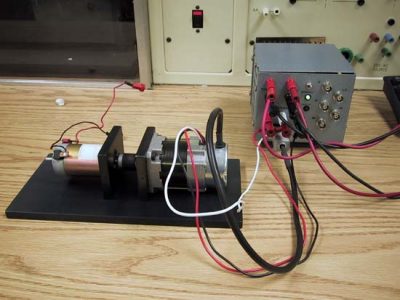
From October 2003 to March 2004, Jonathan Kimball designed new brushless dc (BLDC) drives for laboratory use; assembly was performed by Yongxiang Chen, Alicia Shepherd, and Nathan Brown. Scott McDonald in the ECE Machine Shop designed corresponding dynamometers. The primary end application is ECE431, Electric Machinery, a senior-level lab course at the University of Illinois at Urbana-Champaign. Additionally, it was desired to support features used in research and in other student projects, such as the Future Energy Challenge. It was supported in part by the Department of Electrical and Computer Engineering and in part by the Grainger Center for Electric Machinery and Electromechanics.
SPECIFICATIONS:
The drives were built using IRFIZ48N MOSFETs mounted on a heat sink. The devices are rated for 55 V, 16 mW, 36 A. It is expected that the hex bridge would be able to handle 10 A rms thermally. However, a 50 mW current sense resistor is also used, with other thermal limitations. The current shutdown has been set at 12 A peak, corresponding to 8.4 A rms. The bus capacitors total 940 mF at 63 V. The drives additionally require a 12 Vdc feed for logic supply.
The dynamometers are composed of two motors, a LA052-040E4NL1 BLDC motor from Shinano Kenshi and a FBSM-VE12-6P2133-2 dc motor from Yaskawa (Minertia brand). The BLDC motor is rated at 40 W, 24 V. It is unclear what this 24 V rating refers to, but appears to be the twice the safe limit on bus voltage to the drive to keep the speed reasonable. The dc motor can be used as a generator to apply load to the BLDC motor—simply connect a resistor across its terminals.
DESIGN DETAILS:
The complete design is available in PDF format. Schematic and board layout was performed using the OrCAD suite from Cadence, PSD 15.0. Mechanical design was done in Autodesk Inventor. The estimated material cost of each box is $150, based on one-piece prices from standard vendors. Most components were obtained through Newark, or when possible directly from stock in ECE Stores or the Electronics Shop. Custom boxes were built by eMachineShop, then painted by the ECE machine shop and silkscreened by the ECE Electronics Shop. Heat sink machining was done by the ECE Machine Shop. The bulk of the PCB assembly was performed by the undergrads listed above.
Copyright © 2004 by Jonathan Kimball and Patrick L. Chapman.
All Rights Reserved. May be duplicated for educational use only so long as this notice remains intact.